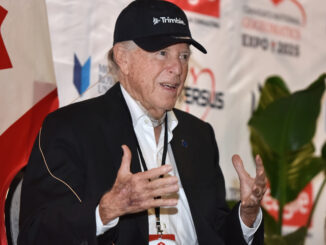
How can today’s surveyors prepare to best support the growing demand to create Smart Digital Realities? This is the question we posed to Thomas Harring, president of Hexagon’s Geosystems division and CEO of Leica Geosystems.
Harring has held key roles in the company and the geospatial side of the AEC industry for many years, assuming his latest position in early 2020. Harring is known for his insights into the current state of and near-future prospects for the industry, so GoGeomatics’ Jonathan Murphy and Gavin Schrock were happy to sit down with Harring for a chat at Intergeo 2022 in Essen, Germany.
Smart Digital Realities™, digital twins, BIM, continuous representation of reality, metaverse (sorry)—call it whatever you wish—the vision of a digital future for AEC is the same. And in many ways this future is already here, or at least the tools are ready for skilled practitioners to build this future. It will take a lot of work; work on such a massive scale that legacy tools and methods will never be able to keep up with demand. It will take specialists in precise and authoritative spatial data capture: surveyors.
However, it will take a new breed of surveyors, those who are able to work harmoniously with increasingly automated sensors, systems, and software. Many surveyors have already embraced this, but many more are needed. How do they prepare for this future?
GoGeomatics: It seems that times of high demand have a Catch-22: everyone is busy, but perhaps too busy to update their tools and methods to meet the increased demand.
Harring: The average is perhaps what you describe; we see surveyors who are leading, and some who are more traditional—this is something we see in many industries. Of course, surveyors are very busy. They all have that in common, especially with the current labor shortages in many places. We can argue whether others could do some of their tasks, but regardless: The high demand is a challenge.
Some may be too busy to be forward-looking and to grow their companies, as you say, but we see many surveying companies of all different sizes and across the world who are highly innovative. They exemplify the very message to the geospatial and surveying community we like to highlight on our website: “Pure surveying and more.” We continue to innovate—as we have done for 200 years. We want to take our surveying community with us on our journey of innovation to help them grow their businesses, for example through reality capture, monitoring and other areas where you need surveying competence and depend on accurate and reliable positional data.
GoGeomatics: Clients for surveying services are under pressure, and may be looking at alternatives, even though this could backfire.
Harring: Yes, sometimes they turn to someone that only knows how to run the scanner. This is thinking myopically; they really need a surveyor. Surveying competencies are needed fast, because it provides the accurate and reliable data that you can count on. Surveyors take the extra care, and therefore might not always be the fastest, but you can rely on the data and the quality; I think that’s given. And, of course when it comes to digital realities, digital twins — who is best prepared to make geospatial data come to life, put it into context and connect different things this way? Yes, surveyors.
And then we see of course, a huge trend of surveyors getting attracted by other industries, for example larger construction companies, energy companies that build in-house surveying departments which can be good and bad. The good thing is that it helps to stimulate the awareness of these technologies across different departments.
At the same time, of course, it increases the pressure on the workforce. Smaller surveying companies, in particular, struggle to hire new talent.
GoGeomatics: In your keynote at HxGN LIVE 2022 (Hexagon’s annual conference and exhibition), you brought up the saying “people do not understand what surveyors do until they stop doing it”. But is it also true that there are new skills, or aspects of these digital realities they will need to embrace before others start doing them?
Harring: Surveyors will need to adapt. In the past surveyors were focused purely on engineering-grade accuracy; visualization was secondary. But you can absolutely have both – visualization and accuracy must now come together. You can see it in Hexagon’s development in reality capture: Our point clouds are not only precise and dense, we also provide extremely nice visualization.
Together with imaging, the data becomes really powerful. You can support decision makers, who do not have surveying expertise, with nice and intuitive visualizations. The rich visualizations, virtual reality, and augmented reality are very practical as well for design, construction, and operation of the infrastructure.
GoGeomatics: People look to increased automation as a way to deal with staffing issues. One of my favorite examples is your AP20 Auto Pole; something I wished could have been automated decades ago.
Harring: That is a great example. We looked at field workflows for many years and asked ourselves: “Where can we help surveyors get more efficient and avoid mistakes?” Think of sources of error like plumbing the rod, erroneously recorded measure-ups, and selection of the wrong targets. We developed the AP20 Auto Pole to speed up field work: Not having to plumb the rod is a substantial time saver. And reducing or eliminating the sources of error results in less rework. This is a common goal for innovation and automation, certainly in all that we develop. We have a lot of surveyors in our development teams and in management so that key decisions are made with input from those with the right domain experience.
The Leica AP20 looks like a small device, but it is very complex. Yet it is very simple to operate which was also a prime goal. Feedback from users is that we truly have helped them become more efficient and avoid mistakes. Every user of the AP20 I talked to says that that they could not imagine working without it anymore.
GoGeomatics: Surveyors are very aware this digital wave is coming; they see it and say, “somebody teach me to swim”. What is your advice for how to prepare for this?
Harring: Start small. Find a small project, get your best people on it—rather than delegating it to just anybody. And then see what kind of benefits new tools and methods provide. When you see early successes, scale it and include it into your normal work processes. That is how you bring additional competence in-house.
It also requires passion, which surveyors typically have; and it takes courage just to get started. Our teams are here to help, and our solutions are getting easier and more intuitive. We can also create awareness of growth opportunities. Internally, we do it as well: We take calculated risks, we dream big, but start small.
GoGeomatics: We hear as well in the surveying community, a substantial number of people who are apprehensive about technology, not quite fear it, but have many reservations.
Harring: It is never just about the technology. We always say when it comes to technology, people really make the difference. Thoughtful people thinking carefully about key questions: what are we doing and what could we be doing with a new technology?
We can also talk to others about their experiences. There are so many communities where surveyors can educate themselves among peers and learn from others. They benefit from associations, other exhibitions, like here at Intergeo. And we can connect people. It’s our duty as a manufacturer, as a vendor, to bring communities together. It’s about enabling the dialogue, which we both host and participate in. We also learn from them. And maybe all of us have to become better to communicate to those outside the industry what geospatial professionals are doing.





Be the first to comment